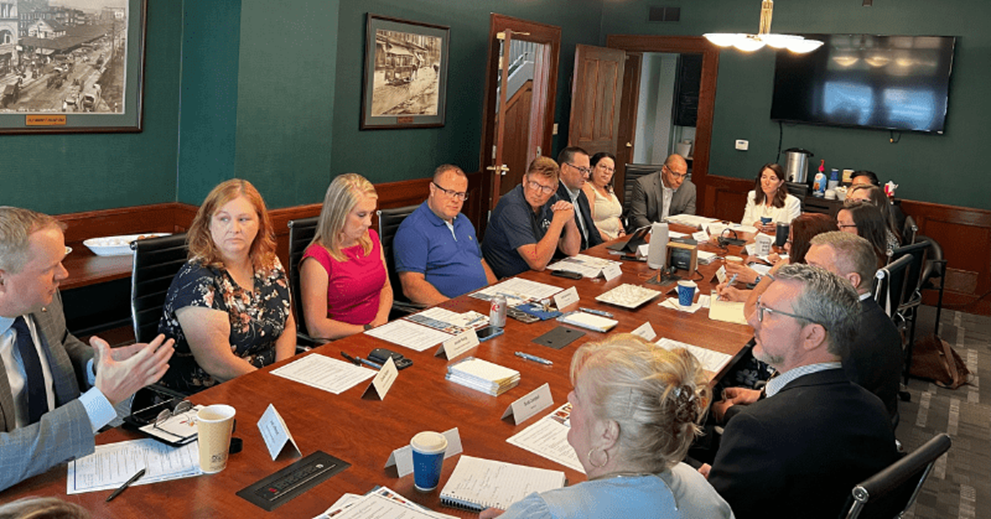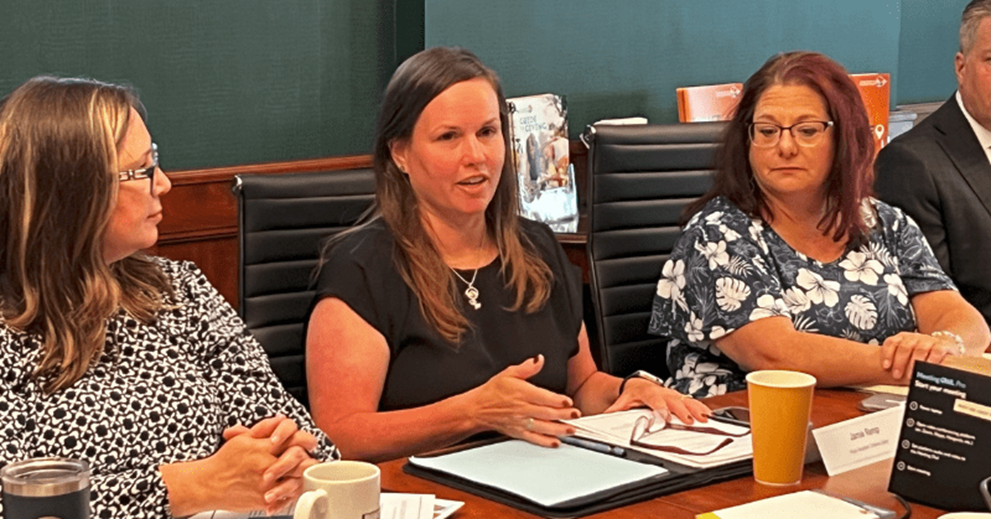- Share
Economic wins fill Wheeling leaders’ sails despite persistent workforce development headwinds
Members of the Wheeling business community shared with President Hammack their work to support business growth and meet the needs of residents for education, childcare, transportation, and healthcare.
On a rainy Friday morning, Cleveland Fed president and CEO Beth Hammack nursed a cup of coffee while she listened to area leaders describe current economic conditions in Wheeling, West Virginia.

Members of the Wheeling business community shared their work within the region to support business growth and meet the needs of residents for education, childcare, transportation, and healthcare
Gathered around the conference table at the Community Foundation for the Ohio Valley were 15 leaders representing a cross-section of the Wheeling economy. It was Hammack’s first time in West Virginia since the start of her tenure at the Cleveland Fed in August 2024. The insights shared by local banking, business, economic development, education, social services, and philanthropic leaders included the following:
Labor, location, and collaboration keep the area competitive. The labor shed of three states (West Virginia, Ohio, and Pennsylvania) remains a competitive advantage for the area, as does the "transportation trifecta" of having easy access to transport options on the river, rail lines, and interstate. This is further supported by the speed at which agencies can work together to support economic development needs. When it comes to West Virginia’s competitiveness, a participant noted that "speed is money."
Economic development success brings workforce development concerns. While the region has secured recent economic development investments including the WVU Cancer Center in Wheeling and Form Energy in Weirton, leaders are concerned that population loss, a lack of single-family housing, a limited transportation network, and a shortage of affordable childcare will limit the ability of residents to access the resulting higher-paying jobs.

Community leaders shared their perspectives on the challenges facing Wheeling residents in maintaining upward economic mobility
Transportation challenges hit hard on two fronts. Many noted the region’s limited transportation network often keeps low-income residents from accessing higher-paying jobs in other locations around the region. The lack of a robust bus network, rideshare drivers, and taxi service also creates barriers to those seeking training and educational opportunities to upskill for higher-wage jobs.
Conversely, the relatively easy commute to Pittsburgh, where wages are much higher for similar jobs, results in labor force shortages in Wheeling. Several sectors such as advanced manufacturing, education, social services, healthcare (physicians and nurses), and IT are particularly impacted.
Businesses continue to be impacted by the benefits cliff. Participants also noted a pronounced benefits cliff in the region, where workers are often unwilling to accept promotions or higher-wage jobs for fear of losing health insurance, food assistance, housing assistance, education stipends, and other benefits.
New barriers to accessing education and skill development are emerging. In addition to concerns around funding cuts to programs that support local food pantries and food-related benefits, leaders noted that decreases in funding to work programs with attached educational stipends had a profound impact on the region. Many residents used these programs' education stipends to upskill for higher-paying job opportunities in the region. According to one participant, less than half of high school graduates pursue education beyond a high school diploma, and many who are able to work remain on the sidelines.
The outlook for project funding remains mixed. Participants did not express specific concerns related to accessing credit for small businesses. However, economic development officials noted that several development projects had not gone forward due to an inability to find financing to "close the last gap" in funding for projects.
About President Beth M. Hammack’s Around the District tour
President Hammack is visiting communities across the Fourth District as part of her Around the District tour to meet and connect with the people who live and work in all corners of the region and to gain a better understanding of how the economy is working in different communities. The Cleveland Fed, with branches in Cincinnati and Pittsburgh, serves an area that comprises Ohio, western Pennsylvania, eastern Kentucky, and the northern panhandle of West Virginia. Hammack will use this information to inform her policy views and better represent the Fourth District around the Federal Open Market Committee table.

